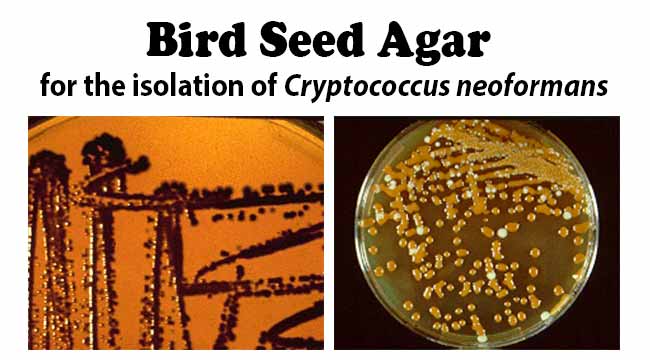Bird Seed Agar is a solid medium used for selective and differential isolation of Cryptococcus neoformans from clinical specimens. Cryptococcus neoformans is an encapsulated yeast that produces the enzyme phenoloxidase, an enzyme necessary in melanin synthesis. The brown pigmented colonies of Cryptococcus neoformans were observed by Staib in 1962 when he grew cultures of the yeast on media containing Guizotia abyssinica seeds. It was later determined that the seeds contain caffeic acid, which served as the melanin-producing substrate. In 1966, Shields and Ajello modified Staib’s Birdseed Agar by making the medium selective with an antimicrobial additive. It is also known as Caffeic Acid Agar or Niger Seed Agar or Staib Agar.
Composition of Bird Seed Agar
| Ingredients | Gms / Litre |
|---|---|
| Guizotia abyssinica (niger seed) | 50 gm |
| Glucose | 1 gm |
| KH2PO4 (potassium dihydrogen orthophosphate) | 1 gm |
| Creatinine | 1 gm |
| Agar | 15 gm |
| Distilled water | 1000 ml |
Final pH 6.5 +/- 0.3 at 25ºC.
Additives: to each 500 ml bottle.
Penicillin G (20 units/ml) = 0.5 ml
Gentamicin (40 mg/ml) = 0.5 ml
Principle of Bird Seed Agar
The extract of Guizotia abyssinica seeds contains caffeic acid which serves as a substrate for the detection of phenoloxidase, an enzyme produced by C. neoformans. The action of phenoloxidase on caffeic acid results in the production of melanin which is absorbed by the yeast cell wall forming a tan to reddish-brown pigmentation. Glucose is the energy source in the medium. Creatinine enhances melanization of some strains of C. neoformans. Agar is the solidifying agent.
Uses of Bird Seed Agar
- It is used for the selective isolation and differentiation of Cryptococcus neoformans from other yeasts.
Preparation of Bird Seed Agar
- Mix the grinded seeds of Guizotia abyssinica with 1000 ml of distilled water.
- Boil for 30 minutes, pass through filter paper and adjust volume to 1000 ml.
- Add remaining ingredients to filtrate and dissolve.
- Autoclave at 110°C for 15-20 minutes.
- Cool to 48°C and add 0.5 ml Penicillin G and 0.5 ml Gentamicin to each 500 ml of Bird Seed Agar.
- Mix gently and pour into petri dishes.
Result Interpretation on Bird Seed Agar

Positive: Development of brown to black pigmented smooth colonies.
Positive Example: Cryptococcus neoformans
Negative: Non-pigmented colonies
Negative Examples: Cryptococcus laurentii, Saccharomyces cerevisiae, E. coli, etc.
Quality Control on Bird Seed Agar
Positive Control: Cryptococcus neoformans ATCC 32045, Growth; brown to black pigmented colonies.
Negative Control: Escherichia coli ATCC 25922, Partial to complete inhibition
Limitations of Bird Seed Agar
- Rare strains of neoformans may not produce pigmented colonies
- Specimens heavily contaminated with bacteria may obscure growth and/or pigmentation of neoformans.
- Aureobasidium, Sporothrix, Wangiella and Phialophora may produce dark brown colonies, but the pigment will not be a result of enzymatic activity which is made evident by pigmentation developing in colonies on all media.
References
- Bird Seed Agar. Mycology Online.
- Birdseed Agar. Remel.
- Ronald M. Atlas and James W. Snyder. Handbook of media for clinical and public health microbiology. CRC Press. 2014 by Taylor & Francis Group, LLC
- https://catalog.hardydiagnostics.com/cp_prod/Content/hugo/CaffeicAcidAgar.htm
- https://www.labce.com/spg603077_recommended_procedure_for_identification_of_crypto.aspx
- Thermo Scientific™ Remel™ Birdseed Agar
Similar Posts:
- Cryptococcus Neoformans – Habitat, Morphology, Epidemiology, Virulence Factors, Treatment + More
- List of culture media used in microbiology with their uses
- Histoplasma Capsulatum – Habitat, Morphology, Epidemiology, Virulence Factors, Treatment + More
- Xylose Lysine Deoxycholate (XLD) Agar- Principle, Uses, Composition, Preparation and Colony Characteristics
